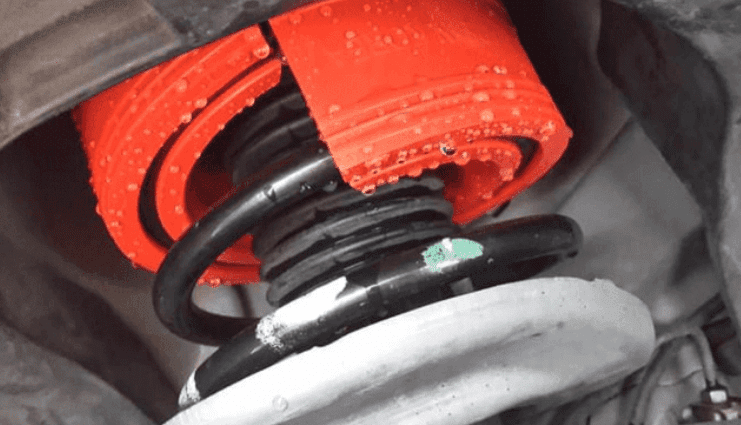Car coil spring buffer pros and cons
A coil spring buffer, also known as a coil spring damper or spring cushion, is an aftermarket product mounted on a coil spring component in a car suspension. Generally, this spring buffer is made of rubber, polyurethane, or silicone, which is attached right between the spring rods of the coil spring.
Based on its use, this spring buffer has a function similar to the strut bump stopper installed in the middle of the shock absorber rod. However, specifically for this aftermarket spring buffer, it is installed in the coil spring.
If the strut bump stopper will directly collide with the shock absorber, the coil spring buffer is only squeezed between the coil spring rods.
Because this coil spring buffer is an aftermarket product, it also has pros and cons for a car suspension system. This article will share information about a car coil spring buffer pros and cons, functions, the benefits and drawbacks of a car suspension.
Check out complete information about the function of the car coil spring buffer pros and cons, the benefits and drawbacks of the car suspension below.
I. The function of coil spring buffer and its benefits
Because the installation location is right on the sidelines of the car coil spring, this coil spring buffer will directly impact the performance of the car's suspension, especially the shock absorber. Below is the function of the coil spring buffer and its benefits for the car suspension system.
A. Improve vehicle stability and handling
The benefits of the coil spring buffer that we will feel for the first time are the increased stability and handling of the vehicle during driving. The coil spring buffer can dampen the oscillating movement of the spring from the coil spring that is too deep, especially when cornering. The coil spring buffer can reduce the symptoms of unsteady body movement such as body roll and bounce.
Reducing body roll symptoms means better control when maneuvering and the car's stability at high speeds. Therefore, don't be surprised if sports cars specifically for race purposes have suspensions that are generally harder and more rigid.
B. Extend the service life of the shock absorber
Spring buffer is also considered to extend the life of the shock absorber. Yes, the spring buffer will directly maintain the distance of the main coil spring to impact the workload received by the shock absorber.
With the spring buffer, the shock absorber load becomes lighter. The pressure and impact received by the wheels from the road surface will be directly dampened by the spring buffer first and then forwarded to other suspension components.
This condition will reduce the damping load that should occur in the shock absorber. By reducing the workload of the shock absorber, the service life of the shock absorber can be longer.
C. Reduces the effect of subsidence suspension
The benefit of using a spring buffer on other coil springs is that the spring buffer can reduce the effect of a sinking suspension. The sinking suspension effect usually occurs due to several things, such as overloading, passing through a fairly deep pothole, and others.
This subsidence suspension effect will cause an impact on the shock absorber so that it will cause a booming sound in the suspension and make the wheels touch on the car body.
By installing a spring buffer on the coil spring, it can reduce this subsidence suspension effect. It means that the coil spring buffer can minimize the noise of the suspension due to the impact of the shock absorber and the wheels.
D. Reduce braking distance
The last benefit of using this spring buffer is that the spring buffer can reduce the braking distance. Although not too significant, the spring buffer can reduce the symptoms of a dip at the vehicle's front end, especially when doing "panic braking" or sudden braking.
The effect produced when the spring buffer dampens this dip effect will directly reduce the braking distance produced by the vehicle. However, from several searches that we did, high-quality spring buffers can generally obtain this benefit.
Read also:II. Negative effects of using car coil spring buffer
Although spring buffers have many benefits on this coil spring, spring buffers can also have negative effects. Here are some of the weaknesses and negative effects that can be caused by using spring buffers on coil springs.
A. Driving comfort is reduced
After installing the spring buffer, the first bad effect is the reduced comfort while driving, especially when passing on bumpy roads. The use of spring buffers on coil springs will directly shorten the suspension spring's playing distance.
The shorter the playing distance of the suspension spring causes the suspension to become more rigid and tougher. As a result, when we drive on bumpy roads, the vibrations due to the impact cannot be fully damped by the shock absorber.
The vibrations and collisions will directly flow to other suspension components. We will feel it directly to the vehicle's body. As a result, the car body will feel more vibrating, which is the cause of reduced driving comfort.
B. Other suspension components become damaged more quickly.
Although installing this spring buffer can extend the shock absorber and coil spring service life, not on other suspension components such as rubber bushings and ball joints.
As we know earlier, the shock absorber's workload becomes lighter due to the installation of this spring buffer. It is not because the shock absorber has strengthened, but rather because the workload that the shock absorber should have absorbed is transferred to other suspension components.
The rubber bushing and ball joint are the weakest suspension components and are easily affected by this workload shift. These components will receive a louder vibration and a heavier load than before to become damaged more quickly.
